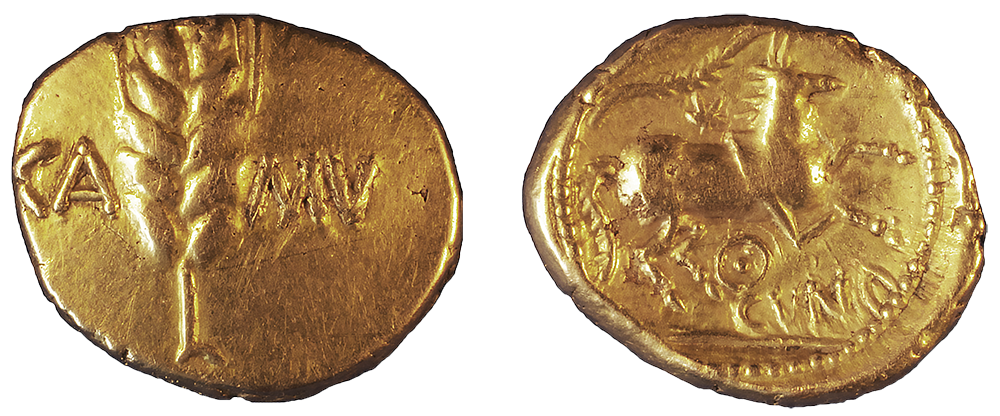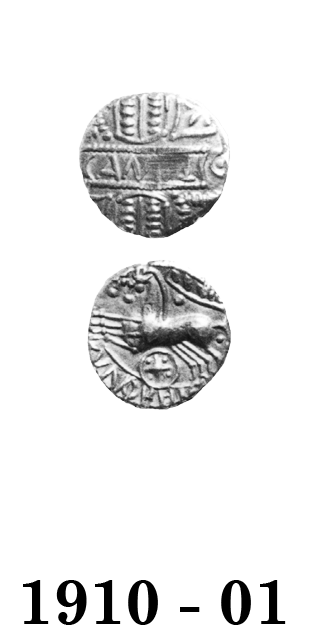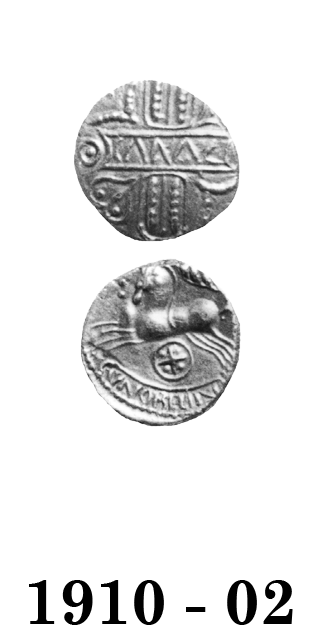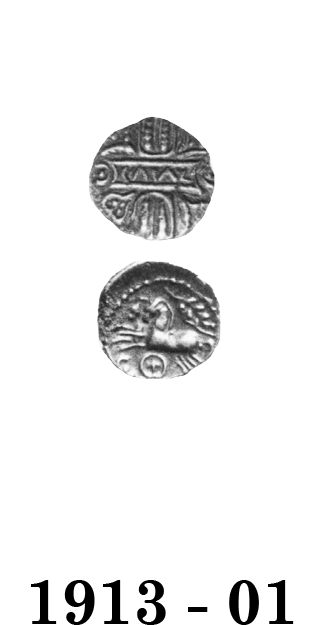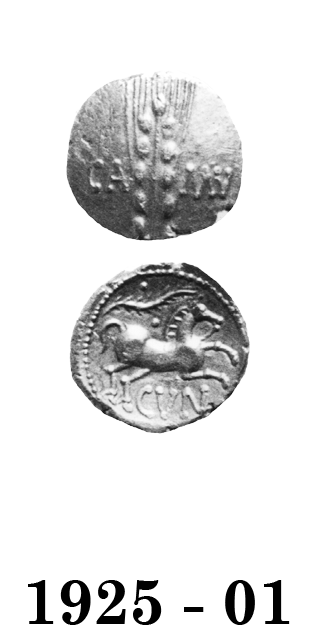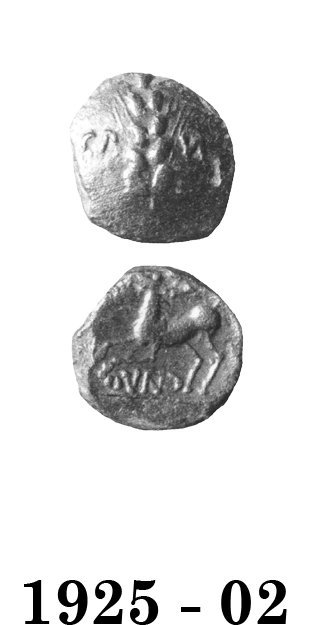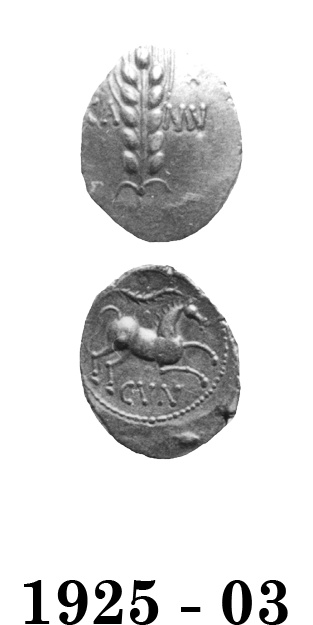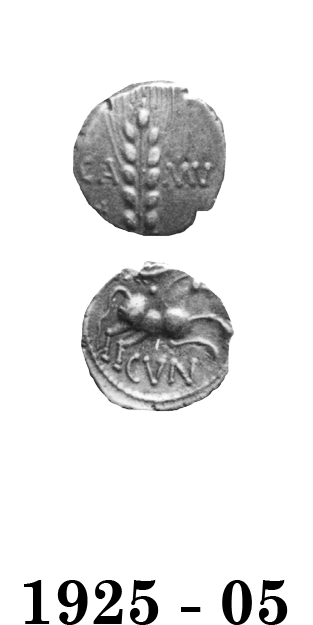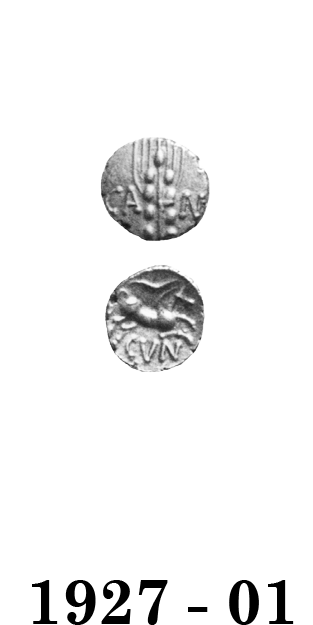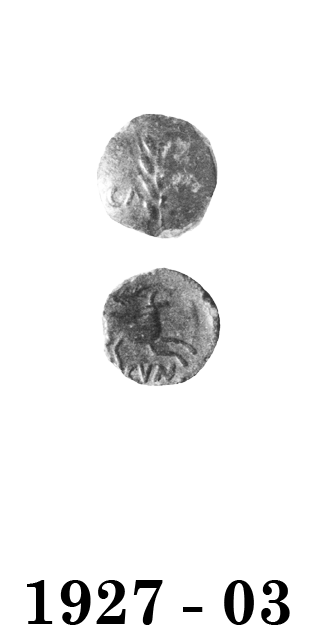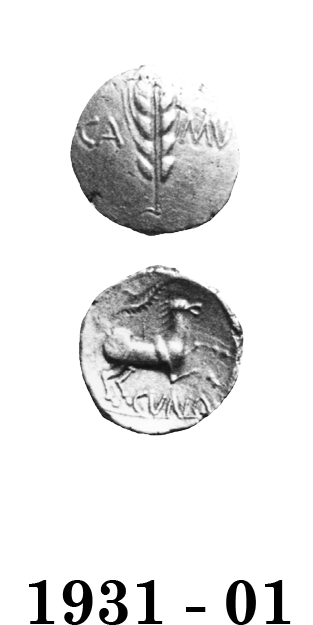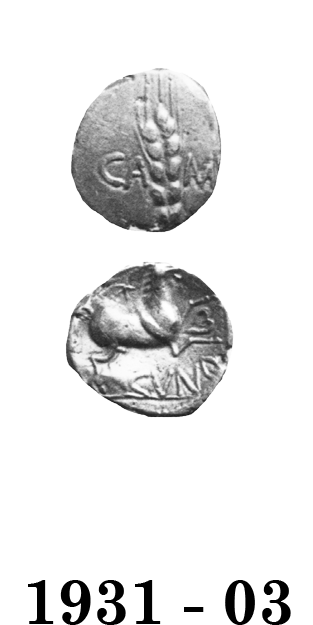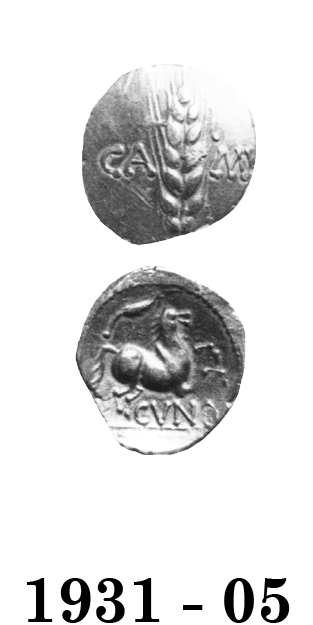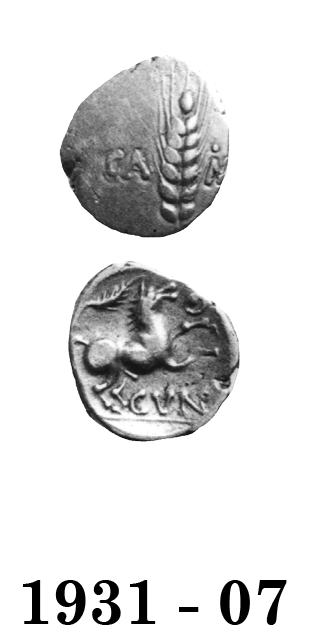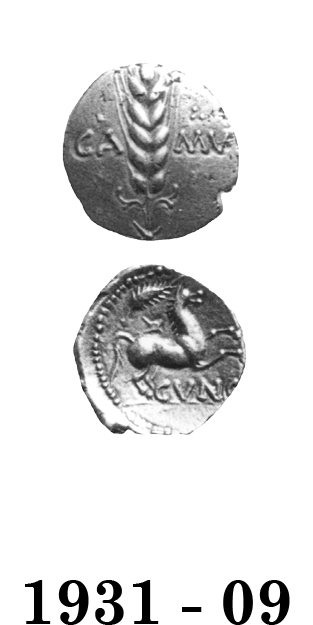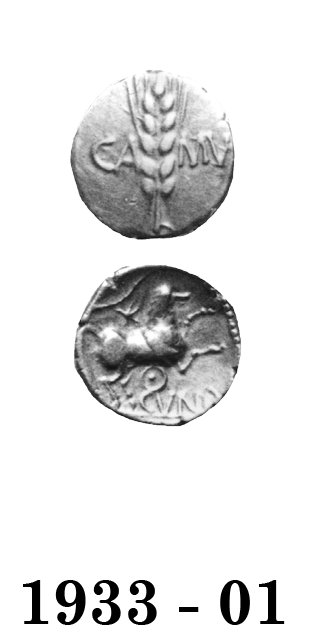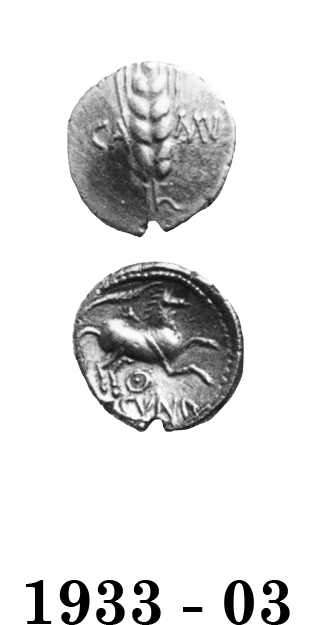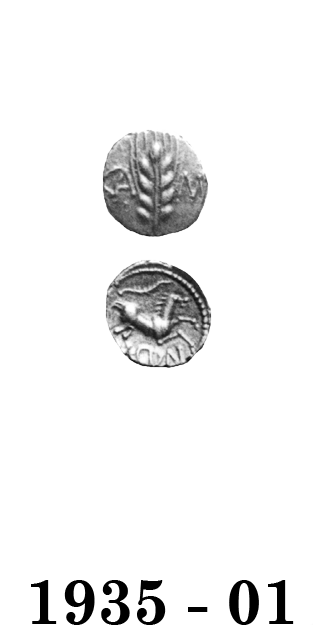
Celtic Coinage of Britain
third edition
Click on coin to see hidden information
The Coinage of Cunobeline
Cunobeline, Shakespeare's Cymbeline, is probably the most well-known of ancient British rulers. We may know more about Commius' place in history, Caratacus' resistance to the Claudian invasion and Boudicca's Revolt, but Cunobeline stands as the stereotype Ancient British "King".
This fame is well-deserved. Accept for the moment that the following narrative is plausible: he ended the Trinovantian/Catuvellaunian Interregnum, creating peace where turmoil had prevailed. He re-established the economic hegemony of the tribe over its neighbours. He ended the Atrebatic/Regnan/Belgic incursion in Kent and possibly established his own rule there.
Will we ever know for certain that all these things happened? Unlikely, but studies of the coins and the work of archaeologists give us additional insights into the period.
Carrying on the tradition of Tasciovanus, he continued to draw the British tribes into the Roman cultural sphere, importing luxury goods on a scale hitherto unknown. Controlling the cross-Channel trade, he gathered tremendous wealth and struck more than a million gold staters. In comparison, the contemporary Atrebatic/Regnan/Belgic ruler, Verica, was able to strike only a third of that quantity.
Cunobeline's economic policies were initially conservative. He is the only ruler credited with trying to reverse the century-long debasement of the currency. On his elevation to power, he restored the weight of the Celtic stater to the 5.6 gramme standard it had been prior to the Interregnum. The restoration was soon reversed since the rest of the British tribes did not support the move. Either he was forced to accept his neighbours' 5.4 gramme reduced weight standard or he saw the reduction as a way to finance growth in his realm.
Of the two alternatives, the positive decision to spur growth was the more likely reason. Cunobeline's neighbours were under his economic influence and he could have forced a general currency reform in Britain by mid-rule, had he chosen. Whether Cunobeline thought in terms of "conservatism" versus "spurring growth" instead of "preserving tradition" versus "needing cash" is certainly questionable. However, the conscious decision to restore the coinage and the equally conscious decision to debase it later, show some understanding of economic principles and Cunobeline deserves recognition for this.
Cunobeline's coinage continues the trend of Romanization, some of his issues are simply copies of Roman coins. The highly stylized Celtic designs disappear by mid-reign, producing a coinage which is very "modern" to us today. To those who prefer La Tene art, the coinage of Cunobeline is a step backwards in artistic accomplishment.
Cunobeline's mint-site at Camulodunum has been excavated, with finds of coin moulds, crucibles and three unstruck bronze flans. An analysis of metal in the moulds show some of the alloys to be the same as those in the bronze coins. However, other moulds contained trace elements found in bronze, generally, but not specifically in the coins. Evidently the site was devoted to wider metal-working activities – perhaps strengthening the suggestion that coinage was a speciality amongst metalworkers. The tremendous output of Cunobeline's mint, however, would have required full-time professional moneyers. The mint site was intentionally destroyed after the Claudian invasion; mint debris was gathered and deposited as rubbish in pits.
Cunobeline's coinage may easily be separated into two periods based on the weight of the staters: the Restoration Period with the heavy staters, and the Expansion Period with the lighter ones. The staters and quarter staters have been chronologically arranged by Allen. There are, however, details which have never been explained, for example privy marks – pellets about the CAMV, and pellets, pellet-in-ring motifs or stars near the Celticized horse. These could be die-control marks or may indicate a change in alloy.
The explanation of the privy marks still represents an opportunity for original research, for a more detailed chronological sequence my be lurking, undetected. An alternate sequence, or more detailed sequence may also be possible if metrological and metallurgical studies are performed. Much work has been done since 1989 to refine the relative chronology of the silver and bronze coins. Yet one suspects that this area still represents another opportunity for original work. Coin authenticators might usefully direct their attentions to the plethora of new types.
An attempt by Fitzpatrick to break the Restoration into early and middle periods (middle when placed in sequence with the Expansion Period) has merit and there is a tentative division used in the following catalogue. In the late 1990's and early 2000's, Philip de Jersey conducted a detailed analysis of Cunobeline's coinage. He concluded that Derek Allen's arrangement of the gold (followed in this catalogue) was still valid. He suggested a modified arrangement for the silver issues – the catalogue notes the instances where this is the case. Basically, the sequence of the silver and bronze issues has traditionally been determined by the style of the coins.
A clarification of the rarity of the staters is in order. The catalogue listings give the rarity for each type. But if minor die varieties are ignored, the coins are much commoner. The following table gives the rarities (as of 2013) ignoring die varieties:
TYPE RARITY
ALL TYPES C
BIGA TYPE R
LINEAR TYPE S
WILD TYPE C
PLASTIC TYPE S
CLASSIC TYPE S
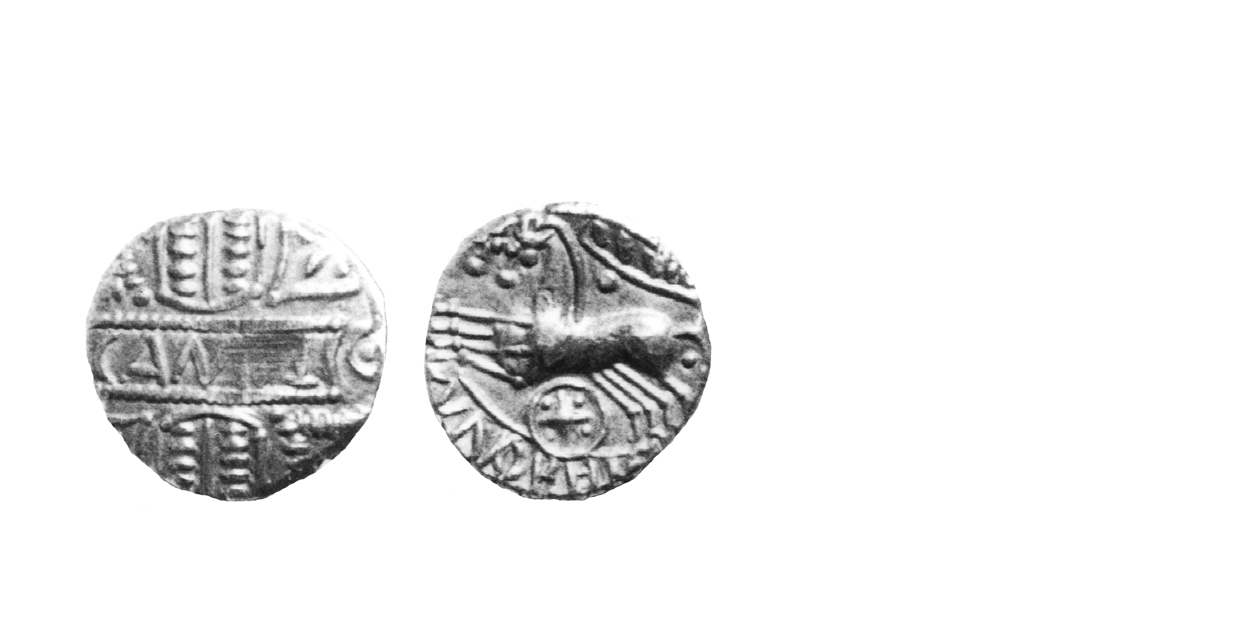
1910 - 01 Cunobeline Biga Type
10-20 A.D. Rare
Gold Stater 5.6 gms. 17 mm
Earliest Record: Evans, 1864
OBV: Inscribed wreath and tablet
Identifying points:
1) CAMUL in tablet
REV: Two Celticized horses left
Identifying points:
1) large leaf above horses
2) four-spoked wheel with pellets between spokes
3) CVNOBELIN below horses
4) pellet below tail and below leaf
CLASSIFICATION: Trinovantian T
NOTES:
- Some in museums
- Standard weight given
- Mack listed the coin twice as 201 and 201a to show the entire reverse image
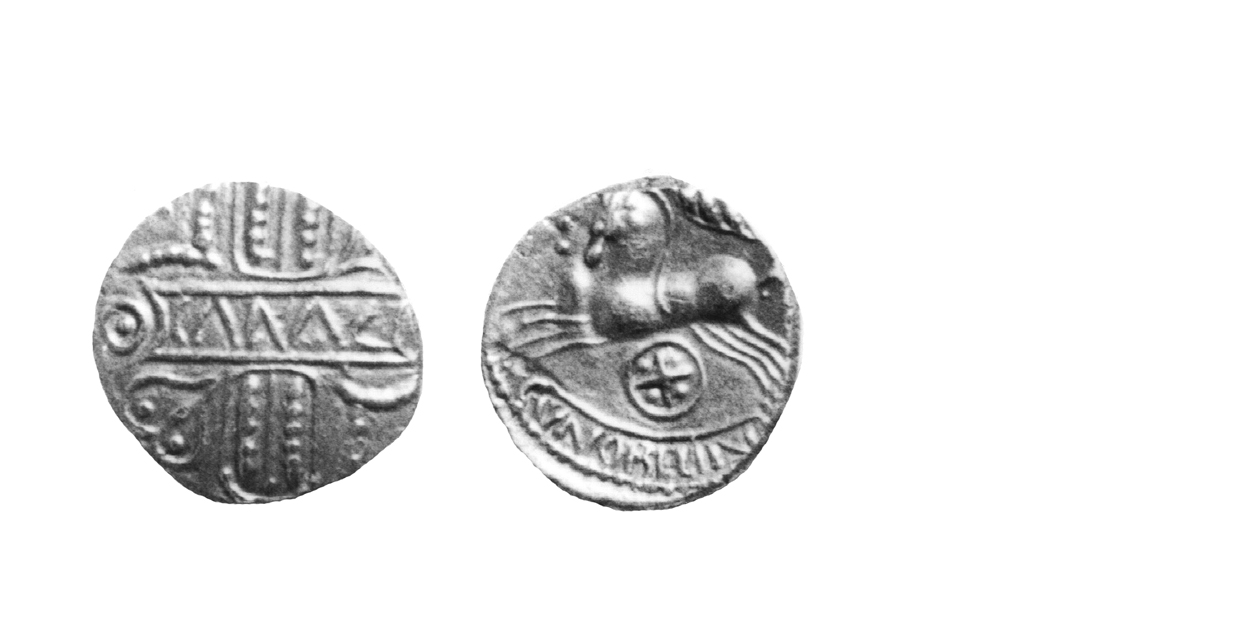
1910 - 02 Cunobeline Biga Type
10-20 A.D. Extremely Rare
Gold Stater 5.6 gms. 17 mm
Earliest Record: Allen, 1944
OBV: Inscribed wreath and tablet
Identifying points:
1) CAMUL in tablet
REV: Two Celticized horses
Identifying points:
1) large leaf above horses
2) four-spoked wheel with pellets between spokes
3) CVNOBELIN below horses
4) no pellet below tail and no pellet below leaf
CLASSIFICATION: Trinovantian T
NOTES:
- Most in museums
- Standard weight given
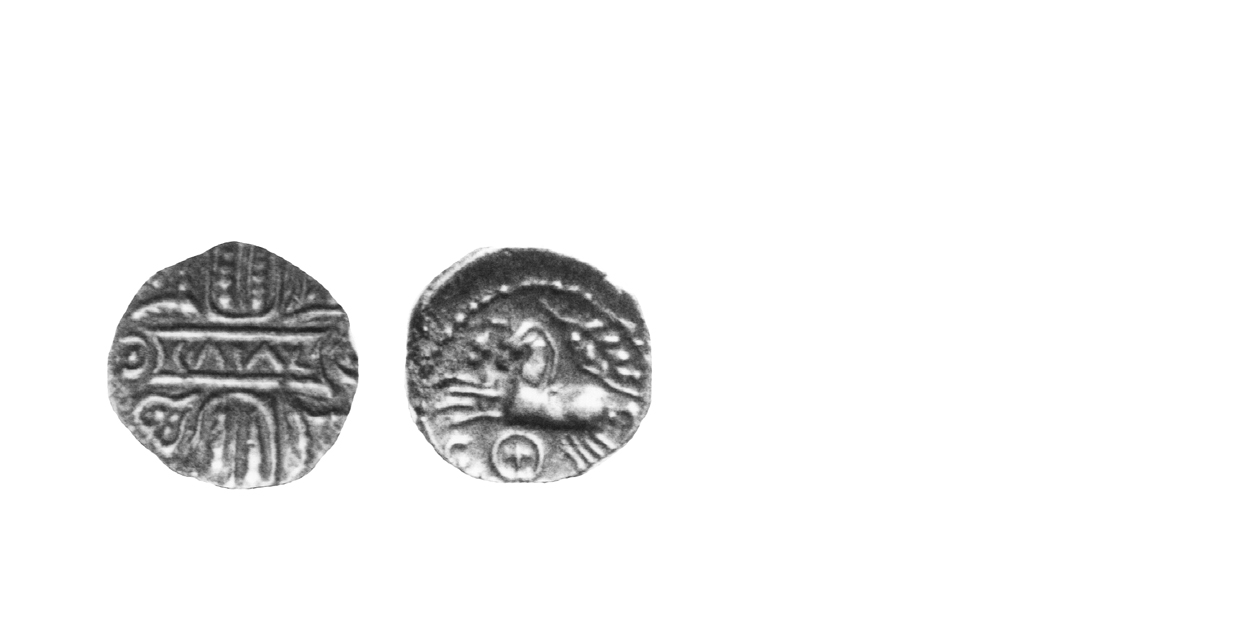
1913 - 01 Cunobeline Biga Type
10-20 A.D. Very Rare
Gold Quarter Stater 1.35 gms. 13 mm
Earliest Record: Allen, 1944
OBV: Inscribed tablet and wreath
Identifying points:
1) CAMUL in tablet
REV: Two Celticized horses left
Identifying points:
1) large, crude leaf above horses
2) four-spoked wheel below horses
3) CVNOBELIN below horses
CLASSIFICATION: Trinovantian T
NOTES:
- Standard weight given
- Object above the horses has been described as a "branch" in the past, but appears to be a degraded image of the leaf, instead.
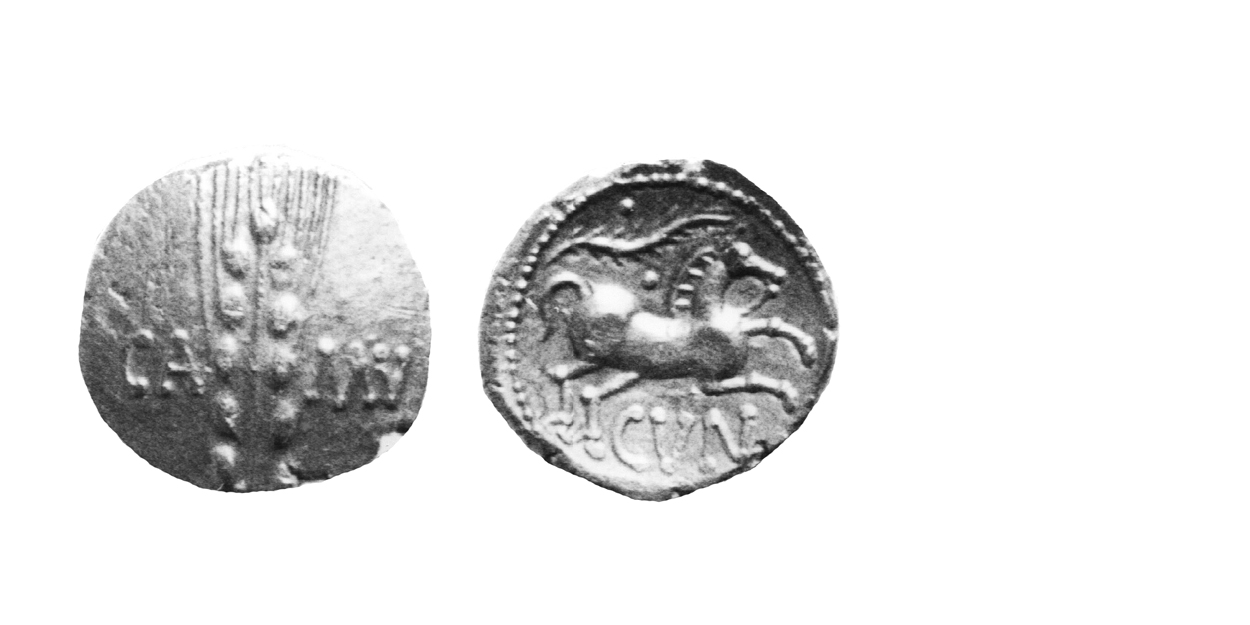
1925 - 01 Cunobeline Linear Type
10-20 A.D. Scarce
Gold Stater 5.6 gms. 18 mm
Earliest Record: Stukeley, 1776
OBV: Corn ear
Identifying points:
1) CA MV to left and right of corn ear
2) corn ear has central stalk
REV: Celticized horse right
Identifying points:
1) branch above horse
2) pellet above and below branch
3) horse's mane made up of a line with smaller lines connecting it to the neck
4) CVN below horse
CLASSIFICATION: Trinovantian U
NOTES:
- Celtic Coin Index records now indicate commoner than previously thought
- Some in museums
- Standard weight given
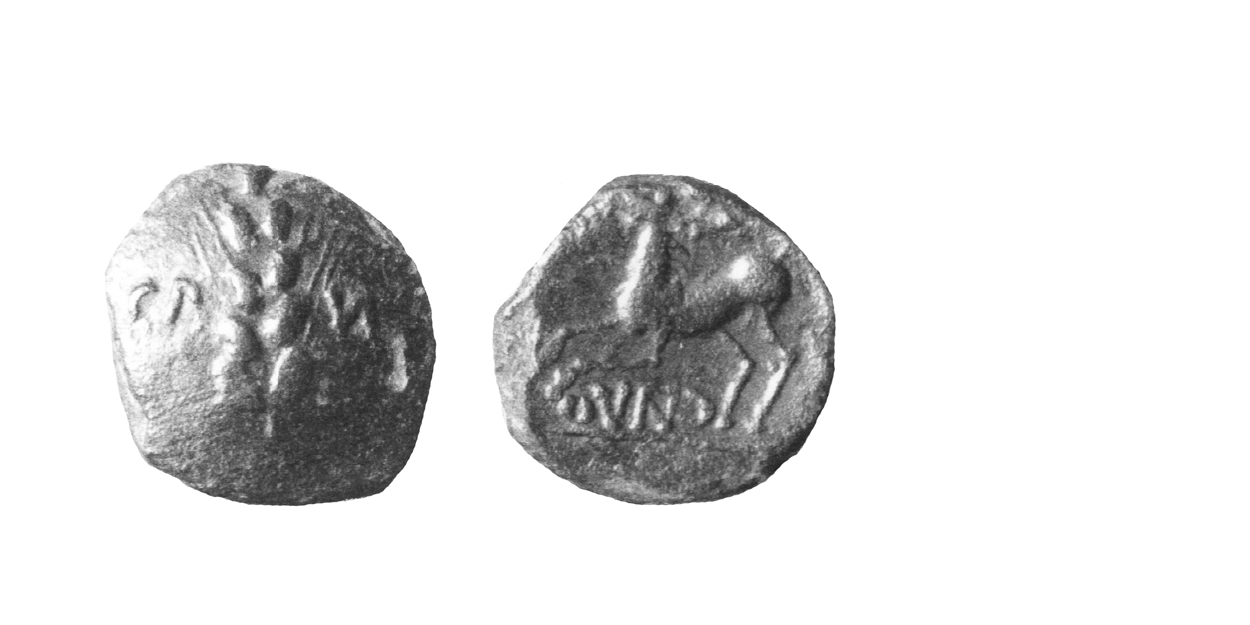
1925 - 02 Cunobeline Linear Type
10-20 A.D. Extremely Rare
Gold/Bronze Plated Stater 4.8 gms. 19 mm
Earliest Record: Van Arsdell, 1989
OBV: Corn ear
Identifying points:
1) CA MV to left and right of corn ear
2) corn ear has no central stalk
REV: Celticized horse left
Identifying points:
1) branch above horse
2) horse's mane made up of a line with smaller lines connecting it to the neck
3) CVNO in mirror-image below horse
CLASSIFICATION: Trinovantian U
NOTES:
- Many in museums
- Ancient forgery from forger's dies
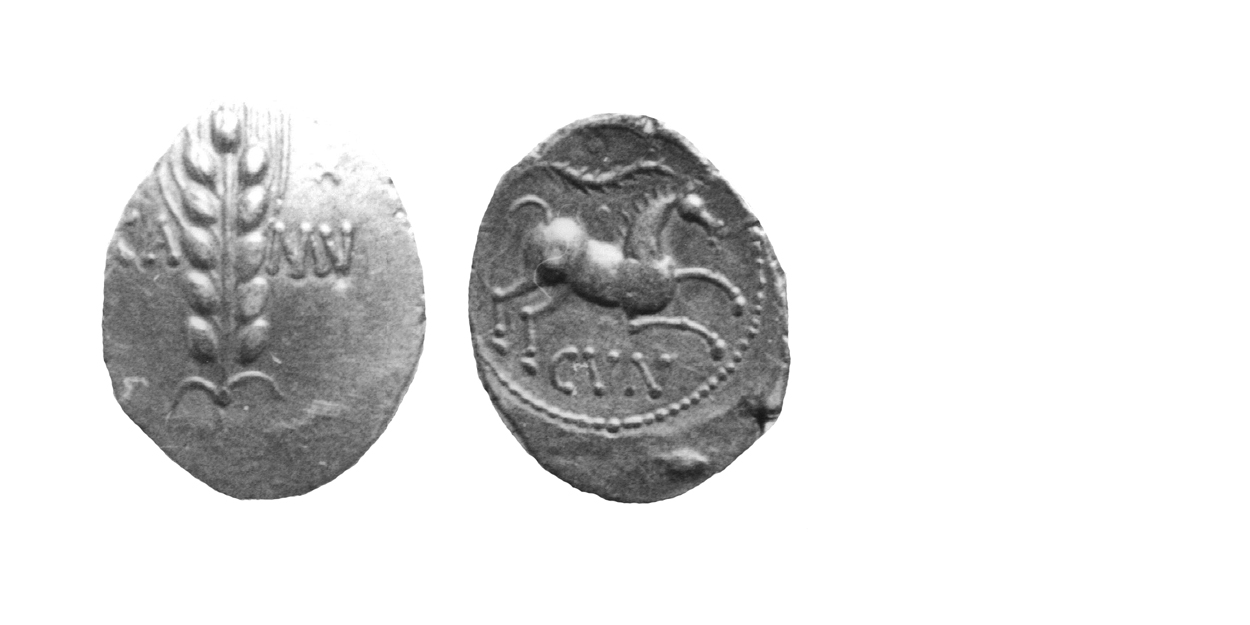
1925 - 03 Cunobeline Linear Type
10-20 B.C. Extremely Rare
Gold Stater 5.6 gms. 20 mm
Earliest Record: Evans, 1864
OBV: Corn ear
Identifying points:
1) CA MV to left and right of corn ear
2) corn ear has central stalk
2) Letter "X" above V in CAMV
REV: Celticized horse right
Identifying points:
1) branch above horse
2) pellet above and below branch
3) horse's mane made up of small lines
4) CVN below horse
CLASSIFICATION: Trinovantian U
NOTES:
- Letter "X" is probably a moneyer's privy mark.
- Standard weight given
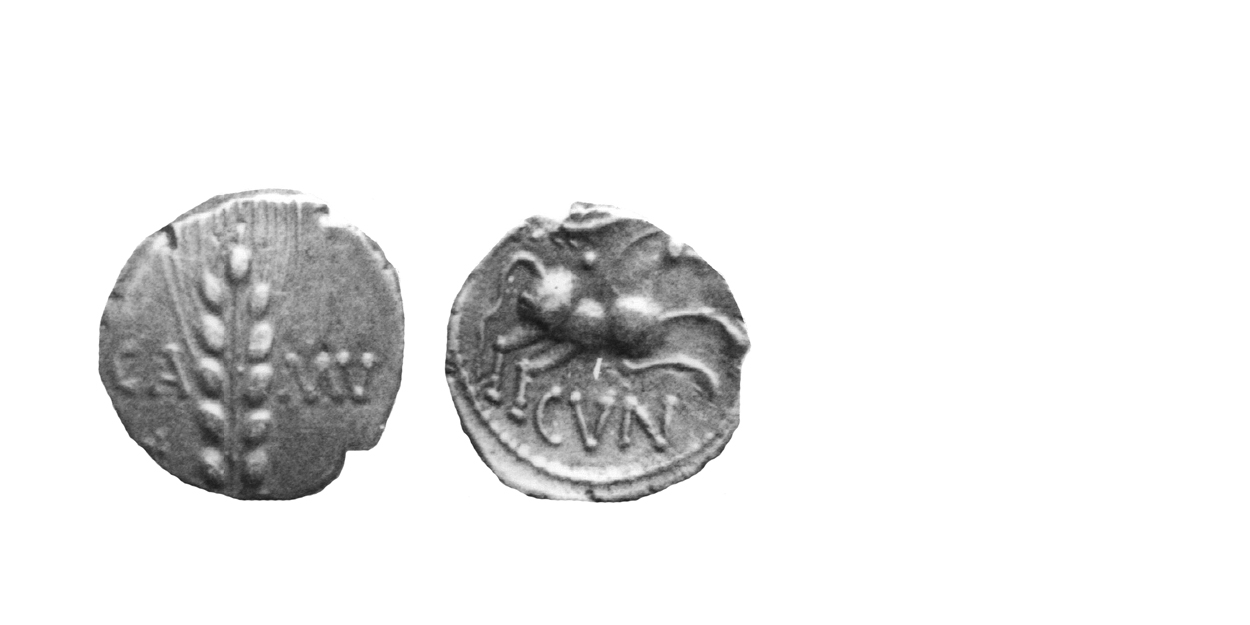
1925 - 05 Cunobeline Linear Type
10-20 B.C. Very Rare
Gold Stater 5.6 gms. 18 mm
Earliest Record: Allen, 1975
OBV: Corn ear
Identifying points:
1) CA MV to left and right of corn ear
2) corn ear has central stalk
3) small letter "X" below A in CAMV
REV: Celticized horse right
Identifying points:
1) branch above horse
2) pellet above and below branch
3) horse's mane made up of a line with smaller lines connecting it to the neck
4) CVN below horse
CLASSIFICATION: Trinovantian U
NOTES:
- Letter "X" is probably a moneyer's privy mark
- Standard weight given
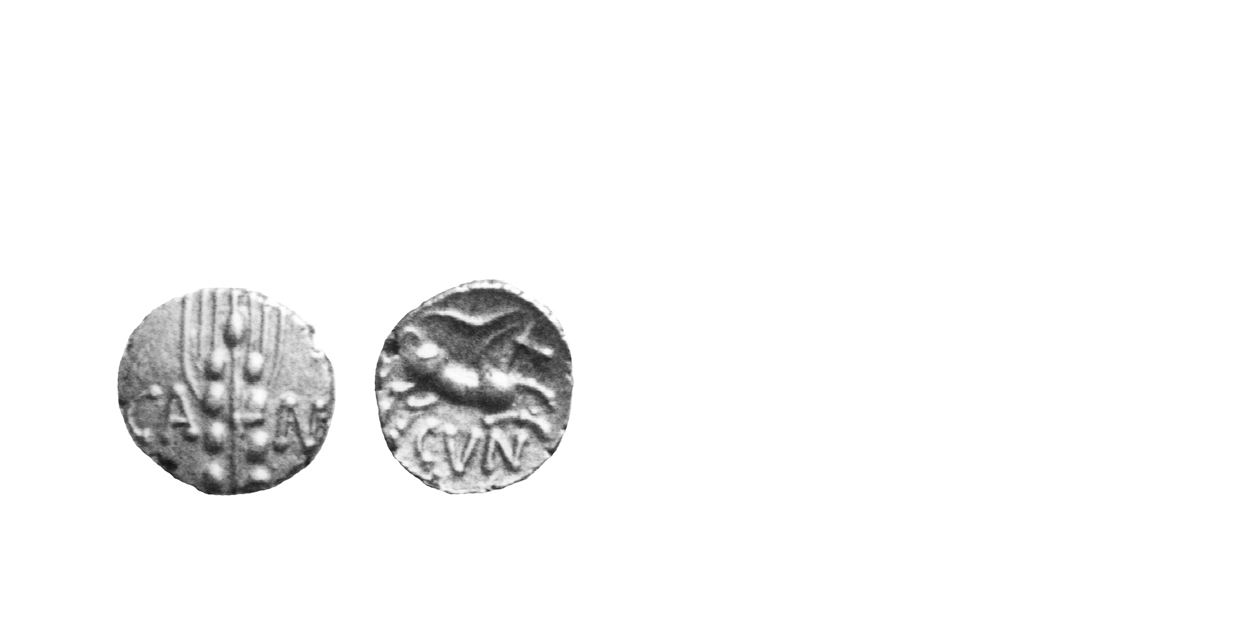
1927 - 01 Cunobeline Linear Type
10-20 A.D. Scarce
Gold Quarter Stater 1.35 gms. 11 mm
Earliest Record: Evans, 1864
OBV: Corn ear
Identifying points:
1) CA MV to left and right of corn ear
2) corn ear has central stalk
REV: Celticized horse right
Identifying points:
1) branch above horse
2) horse's mane made up of a line with smaller lines connecting it to the neck
3) CVN below horse
4) no pellets above and below wreath
CLASSIFICATION: Trinovantian U
NOTES:
- Celtic Coin Index records now indicate commoner than previously thought
- Some in museums
- Standard weight given
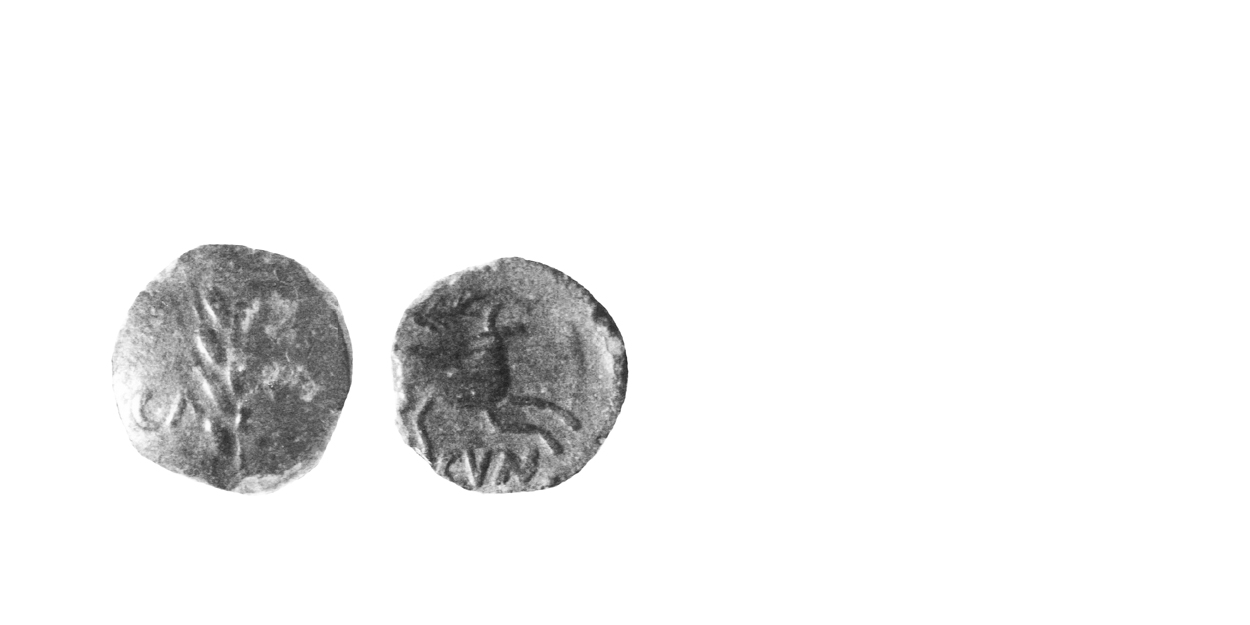
1927 - 03 Cunobeline Linear Type
10-20 A.D. Extremely Rare
Gold/Bronze Plated Quarter Stater 1.0 gm. 13 mm
Earliest Record: Van Arsdell, 1989
OBV: Corn ear
Identifying points:
1) CA MV to left and right of corn ear
2) corn ear has central stalk
REV: Celticized horse right
Identifying points:
1) branch above horse
2) CVN below horse
3) no pellets above and below wreath
CLASSIFICATION: Trinovantian U
NOTES:
- Ancient forgery, probably from forger's dies
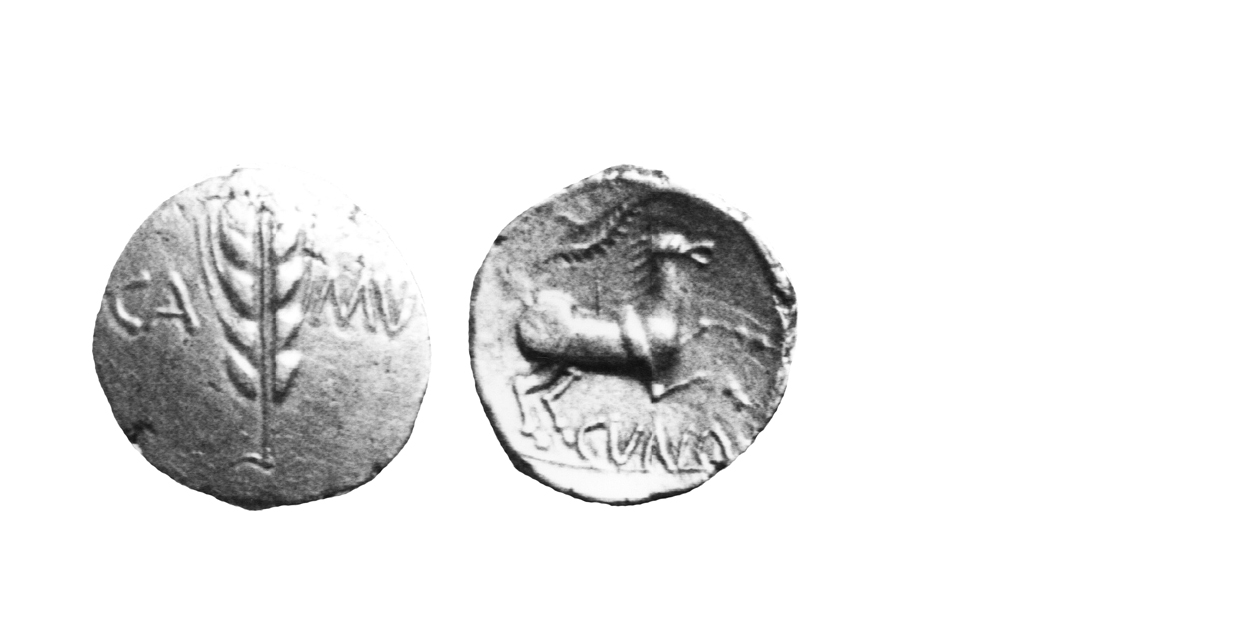
1931 - 01 Cunobeline Wild Type
10-20 A.D. Scarce
Gold Stater 5.6 gms. 18 mm
Earliest Record: Mack, 1953
OBV: Corn ear
Identifying points:
1) CAMV about corn ear
2) central stalk
REV: Celticized horse right
Identifying points:
1) branch above horse
2) CVNO below horse
CLASSIFICATION: Trinovantian V
NOTES:
- Standard weight given
- Some in museums
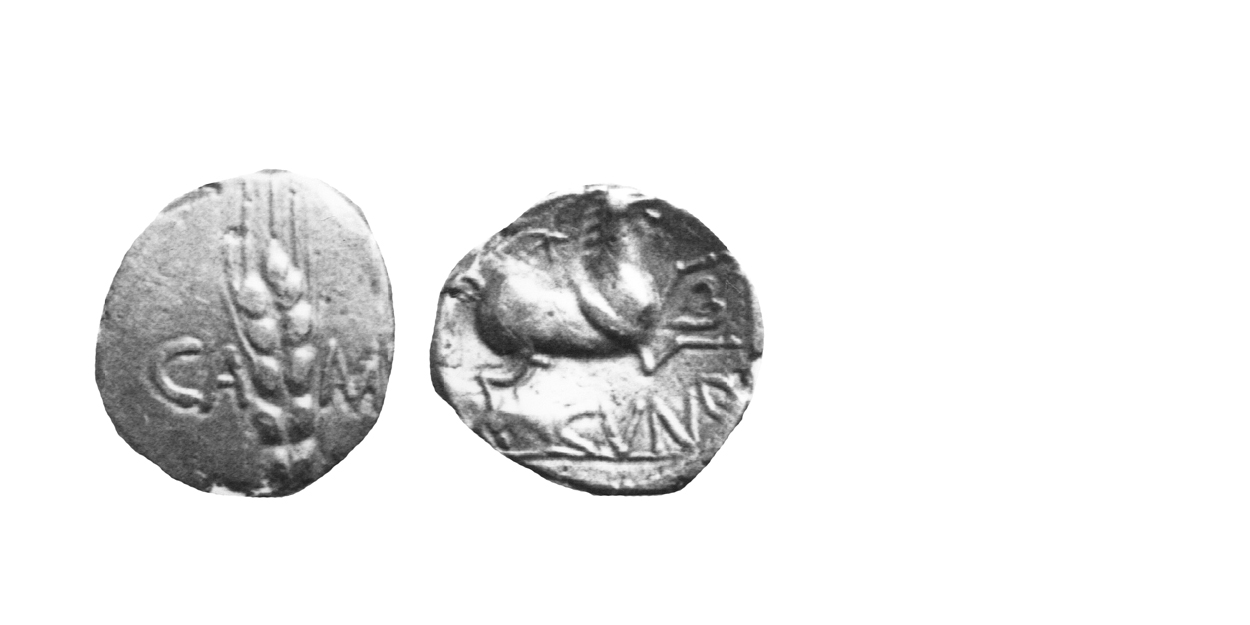
1931 - 03 Cunobeline Wild Type
10-20 A.D. Extremely Rare
Gold Stater 5.6 gms. 18 mm
Earliest Record: Allen, 1975
OBV: Corn ear
Identifying points:
1) CAMV about corn ear
2) no central stalk
3) heart between front legs
REV: Celticized horse right
Identifying points:
1) branch above horse
2) CVNO below horse
2) star above horse
CLASSIFICATION: Trinovantian V
NOTES:
- Standard weight given
- Star is probably a privy mark
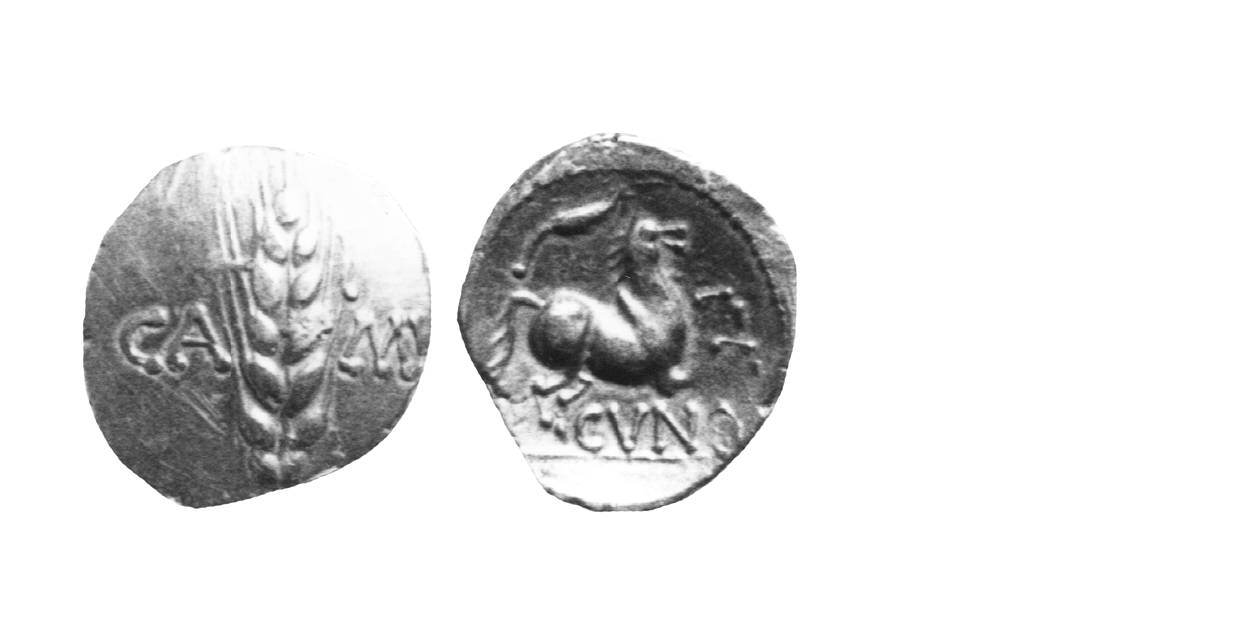
1931 - 05 Cunobeline Wild Type
10-20 A.D. Extremely Rare
Gold Stater 5.6 gms. 20 mm
Earliest Record: Allen, 1975
OBV: Corn ear
Identifying points:
1) CAMV about corn ear
2) no central stalk
3) pellet below A in CAMV
4) pellet above M in CAMV
REV: Celticized horse right
Identifying points:
1) branch above horse
2) CVNO below horse
3) no pellet-in-ring motif in front of horse
CLASSIFICATION: Trinovantian V
NOTES:
- Standard weight given
- Pellets are probably privy marks
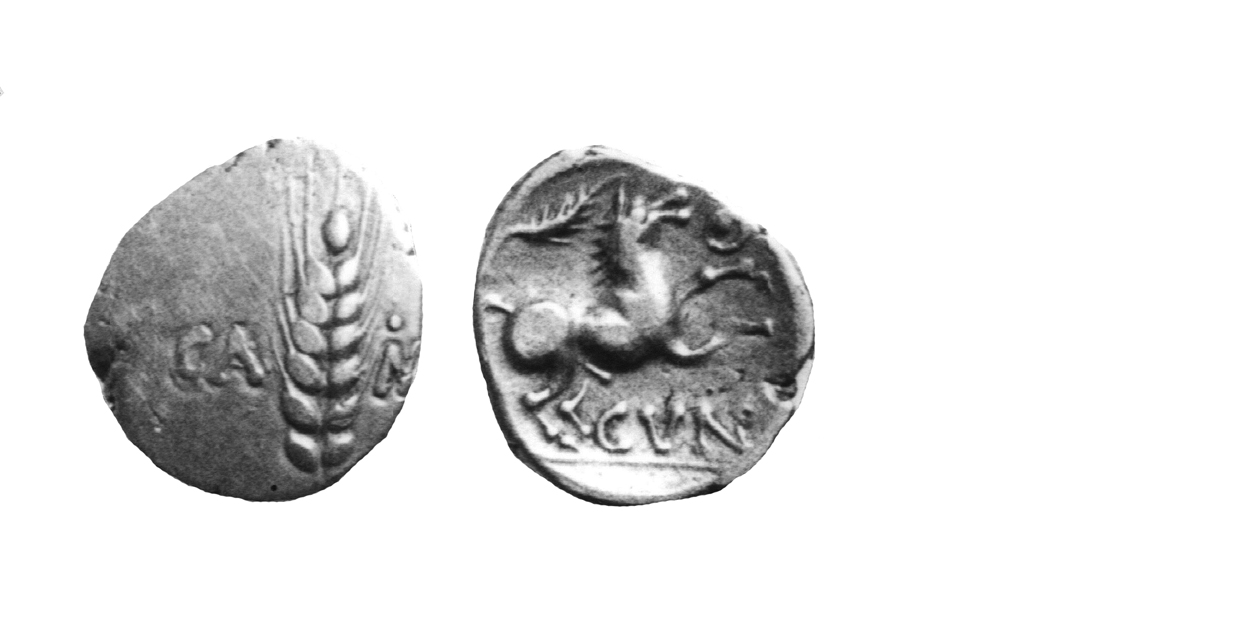
1931 - 07 Cunobeline Wild Type
10-20 A.D. Extremely Rare
Gold Stater 5.6 gms. 18 mm
Earliest Record: Allen, 1975
OBV: Corn ear
Identifying points:
1) CAMV about corn ear
2) no central stalk
3) pellet above M in CAMV
REV: Celticized horse right
Identifying points:
1) branch above horse
2) CVNO below horse
3) pellet-in-ring motif in front of horse
CLASSIFICATION: Trinovantian V
NOTES:
- Standard weight given
- Pellet is probably a privy mark
- Appears to be no pellet above C in CAMV
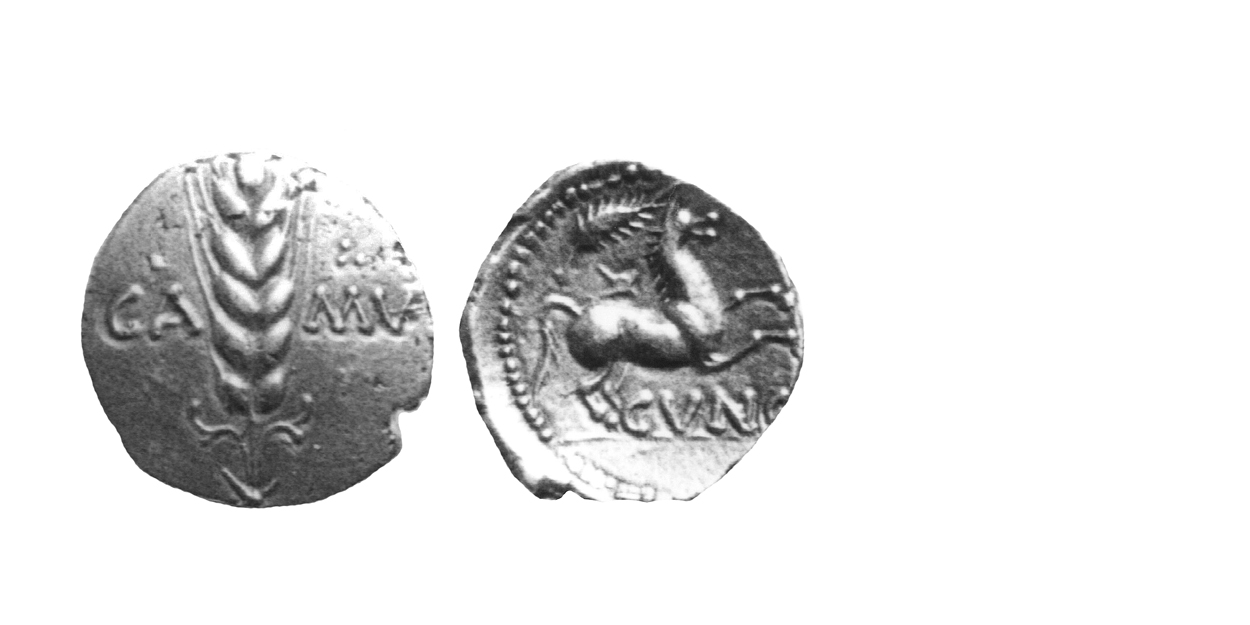
1931 - 09 Cunobeline Wild Type
10-20 A.D. Extremely Rare
Gold Stater 5.6 gms. 19 mm
Earliest Record: Allen, 1975
OBV: Corn ear
Identifying points:
1) CAMV about corn ear
2) no central stalk
3) pellet above A in CAMV
4) three pellets above M in CAMV
REV: Celticized horse right
Identifying points:
1) branch above horse
2) CVNO below horse
CLASSIFICATION: Trinovantian V
NOTES:
- Standard weight given
- Pellets are probably privy marks
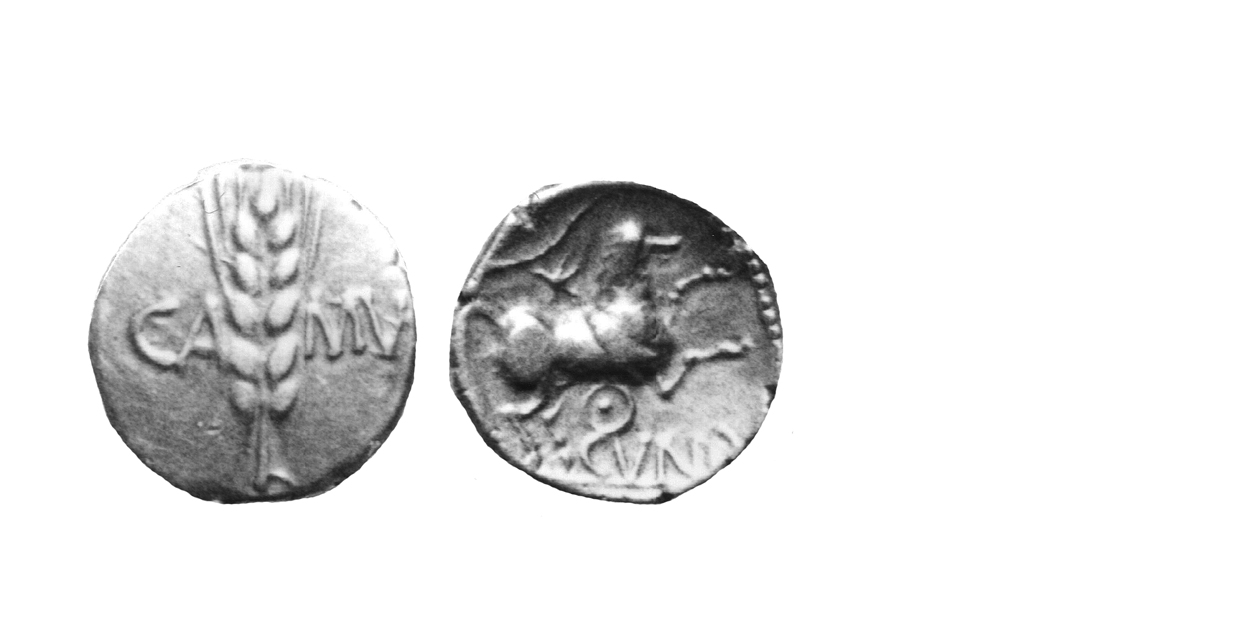
1933 - 01 Cunobeline Wild Type
10-20 A.D. Rare
Gold Stater 5.6 gms. 17 mm
Earliest Record: Evans, 1864
OBV: Corn ear
Identifying points:
1) CAMV about corn ear
2) no central stalk
REV: Celticized horse right
Identifying points:
1) branch above horse
2) CVNO below horse
3) pellet-in-ring motif below horse
4) large star above horse
CLASSIFICATION: Trinovantian V
NOTES:
- Some in museums
- Standard weight given
- Star is probably a privy mark
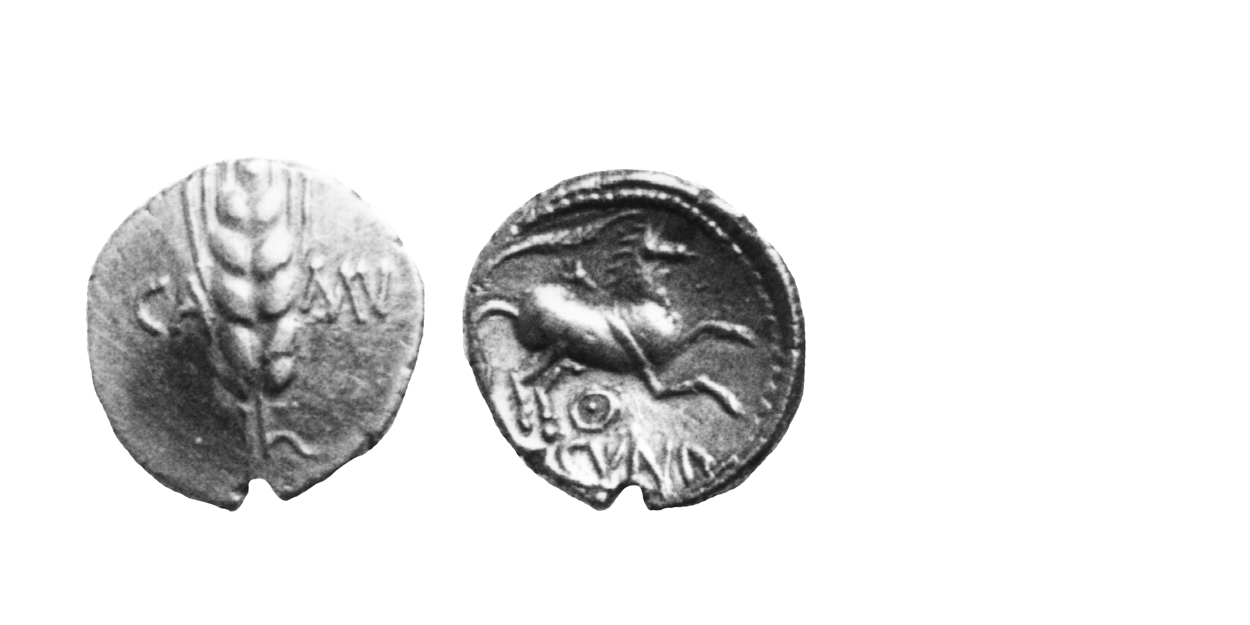
1933 - 03 Cunobeline Wild Type
10-20 A.D. Rare
Gold Stater 5.6 gms. 18 mm
Earliest Record: Allen, 1975
OBV: Corn ear
Identifying points:
1) CAMV about corn ear
2) no central stalk
REV: Celticized horse right
Identifying points:
1) branch above horse
2) CVNO below horse
3) pellet-in-ring motif below horse
4) small star above horse
CLASSIFICATION: Trinovantian V
NOTES:
- Standard weight given
- Star is probably a privy mark
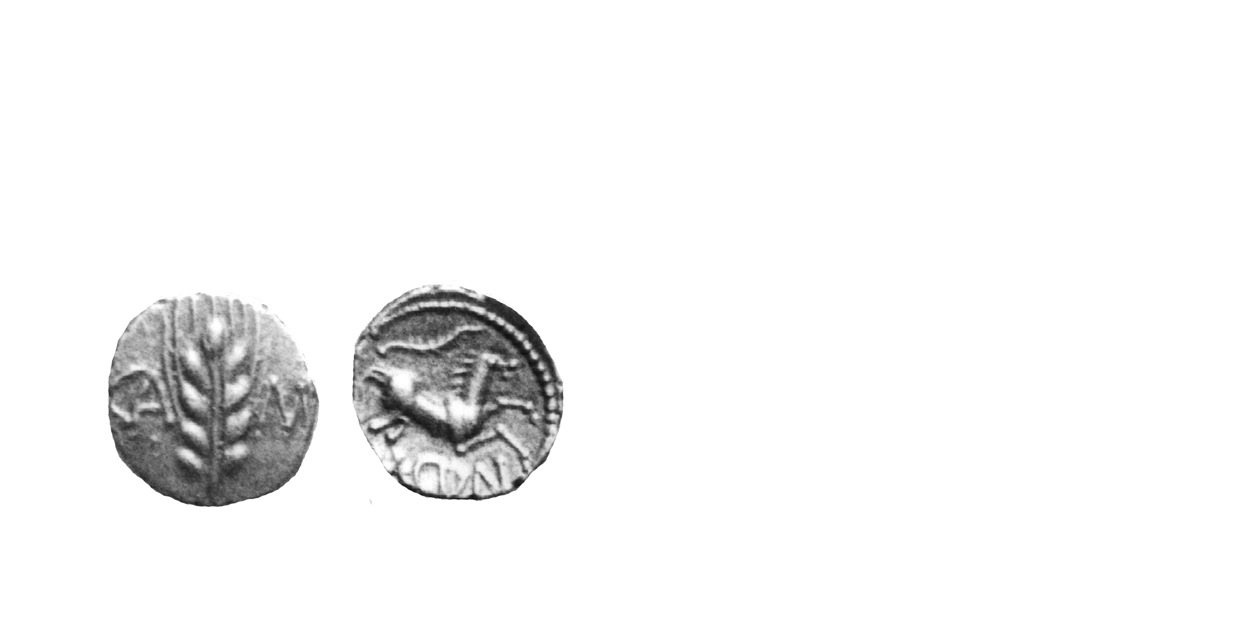
1935 - 01 Cunobeline Wild Type
10-20 A.D. Scarce
Gold Quarter Stater 1.35 gms. 12 mm
Earliest Record: Allen, 1975 (cites Taylor Combe, 1814, p. 14, n. 9)
OBV: Corn ear
Identifying points:
1) CAMV about corn ear
2) corn ear has central stalk
REV: Celticized horse right
Identifying points:
1) branch above horse
2) CVN below horse
CLASSIFICATION: Trinovantian V
NOTES:
- Celtic Coin Index records now indicate commoner than previously thought
- Many in museums
- Standard weight given
Coinage of the Trinovantes/Catuvellauni
Traditionally, the Trinovantes and Catuvellauni were considered distinct tribes, each with its own coinage. An elaborate history, written from the coin inscriptions, described a long intertribal warfare. The Trinovantes received blow after devastating blow from the warlike Catuvellauni and lost Camulodunum, their tribal capital, several times in the process. The evidence was founded partially on Caesar's writings – the ruler of the Trinovantes had been killed by Cassivellaunus. Cassivellaunus was assumed to be a ruler of the Catuvellauni, though Caesar never stated so. The rest of the support came from an analysis of the findspots of the Dynastic coins.
Today, this history is considered a myth – the coin evidence no longer supports continual internecine warfare north of the Thames. Cassivellaunus' tribal origin is not mentioned by any contemporary writer and there is no indication he was the ruler of the Catuvellauni. The similarity of the tribal and personal names is coincidence, not a link between the two. Furthermore, recent analyses of the findspot distributions indicate the coins circulated farther afield than previously thought. The territory north of the Thames can no longer be separated into two distinct coin-using zones.
Instead, the coinage is seen today as that of a single economic group – coin types appear in succession and circulate not only throughout the area immediately north of the Thames, but into Icenian and Cantian territory as well. Metrology and typology show the inscriptions on the dynastic issues are those of successive rulers, not contemporary adversaries.
In general, the picture today is of a powerful, united tribe occupying the area north of the Thames. The unification must have occurred shortly before the Gallic War, or during it. This unified tribe had economic influence beyond its borders which increased throughout the period of the coinage. The tribal group ultimately controlled the economy of the Cantii, and to a lesser extent the economies of the Iceni and Atrebates/Regni/Belgae.
But what was this group group?
That two tribes existed is not in doubt. Caesar mentions the Trinovantes in his Gallic War commentaries, stating they were probably the most powerful tribe in southern Britain. The Catuvellauni are mentioned on an inscribed Roman stone from Hadrian's wall. There were two minting centres in the territory, at the tribal oppida of Verulamium and Camulodunum, suggesting two political centres existed. However, the coinage is a unified one since the two tribal groups must have merged into a single economic unit before they started producing coins. As a result, the tribes cannot be distinguished numismatically, and they are referred to as the Trinovantes/Catuvellauni. For all practical purposes, by the introduction of the Whaddon Chase Type about 55 B.C., they had come to act as one economically, and perhaps had been doing so as early as 125 B.C. The inscribed coinage argues for political unity by 40 B.C. as well. The dynastic coins show an orderly succession of rulers, except for a brief period around the turn of the millenium. This appears to have been an Interregnum, during which the succession was disputed.
The Trinovantes/Catuvellauni occupied the entire territory immediately north of the Thames. They were bounded on the north-east by the Iceni, on the south by the Cantii and Atrebates/Regni/Belgae, on the north the by the Corieltauvi, and on the west, probably, by the Dobunni. Thus, they were in physical contact with all the tribes of the south-east, and in a position to exert influence.
By 125 B.C.. they were importing coins from the Ambiani on the Continent, and shared the cross-Channel trade with the Cantii and Atrebates/Regni. Large Flan, Defaced Die and Abstract Type gold coins are found throughout their territory in quantity.
When the Cantii began casting bronze coins about 100 B.C., the Trinovantes/Catuvellauni followed this lead and produced their own cast coinage for a brief period. In the early 1980s a small hoard of unusual cast bronze coins was dispersed in Europe, about 100 to 300 pieces with an alleged 'Folkestone findspot'. At first this was dismissed as incorrect, and the coins branded Gaulish. However, during the late summer of 1987 a hoard of about 2,000 cast bronzes, including the unusual type, were found in a pit in the vicinity of West Thurrock, Essex. The coins occurred in at least sixteen varieties, with a reasonable typological progression. One coin had a large protrusion of flash which would have broken off had the coin been moved any great distance. In general, the hoard appeared to be made up of coins collected by a mint, perhaps for remelting. No other evidence of minting activity was noted at the site, but it appears the mint cannot have been far away.
THURROCK TYPE cast bronzes are also found as single finds in Essex. A few have been found in the Thames River and one coin was found in Dorset. Many single finds and one small hoard have been found in Kent, prompting some to the conclusion they are a Kentish issue. The coins cannot have been used for a very long time. Three interpretations are likely: 1) they have a Gaulish origin and were briefly imported, 2) they have a British origin and represent the first coinage of the Trinovantes/Catuvellauni, or 3) they are a Kentish issue. Although similar coins are reported from the Continent (Castelin, 1978, numbers 477 to 485), they are not sufficiently alike to have a common Gaulish origin. Thus, of the three interpretations, the Gaulish origin appears the least likely. The Thurrock Hoard, representing a complete corpus of the series, would have been very difficult to assemble outside the mint – it very well may be a hoard of mint scrap. Thus, the suggestion here is that the Thurrock Hoard was produced in the vicinity of the findspot – the coins representing a Trinovantian/Catuvellaunian issue.
Thurrock Types appear to have been influenced by the Prototype Period cast bronzes of the Cantii, dating them about l00 to 90 B.C. Within twenty years, the tribe was striking its own gold coinage.
The Trinovantes/Catuvellauni were one of the earliest tribes to begin striking gold staters, with the introduction of the CLACTON and NORTHERN WESTERHAM TYPES around 70-60 B.C. A hoard of the CLACTON TYPES was found with Ambiani Abstract Type staters at Clacton beach. This type, like all the early types struck in Britain was, short-lived – submerged by the large influx of Gallic War staters. About the middle of the war, the tribe began to strike the WHADDON CHASE TYPE, and continued to produce coins until the Claudian invasion a hundred years later.
The Trinovantes/Catuvellauni apparently collaborated with the Romans during the War. They probably did this by hampering trade between the Durotriges and the Armorican tribes, by competing for supplies within Britain. They may have delivered supplies directly to the Roman army, as well. The tribe obtained a large amount of gold for this effort and evidently became the recipient of wine-trading rights with the Romans. This favour ultimately gave the tribe an economic superiority over all the other tribes in the southeast after the war.
The tribe operated two mints, one at Verulamium, the other at Camulodunum. Initially, the Verulamium mint produced most of the coins, but it was overshadowed by Camulodunum in the first century A.D. The remains of both mints have been found during archaeological excavations.
It has long been asserted that Caesar gave coin-manufacturing assistance during his visit in 54 B.C., because the coins of the period display Romanizing influences. Training was probably unnecessary, however, because the moneyers would have been expert metal-workers already. The die-cutting on Whaddon Chase staters is excellent, but surprisingly, the dies were cut in soft metal. They broke up quickly and many of the existing pieces show die-damage. Sometimes depressions appear where the die surface heaved up during punching. Normally, the heaved surfaces would have been planed off, but this was not done for some reason. All this suggests that the minting was hurried, not unusual for a time of war.
The Trinovantes/Catuvellauni continued to produce coins after the War, and there appears to be little reduction in the amount produced. A silver coinage started either during the War or just after. Shortly after Commius placed his name on the Atrebatic/Regnan/Belgic coinage, the tribe began its own dynastic series, probably around 40 B.C. By this time the tribe was producing bronze coins for small change, as well as gold and silver. The series of inscribed coins gives the names of the successive tribal leaders for the next eighty years.
